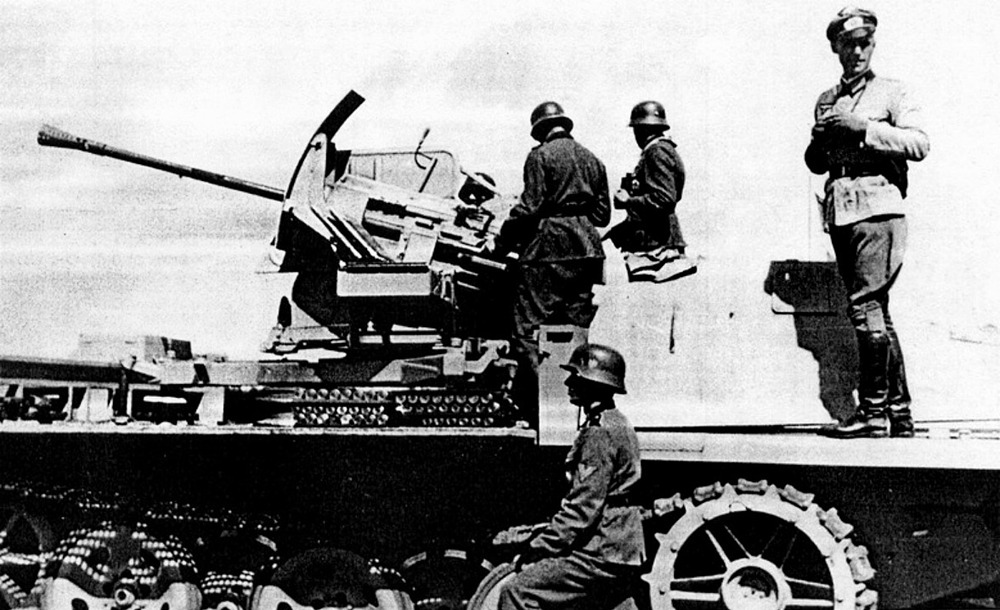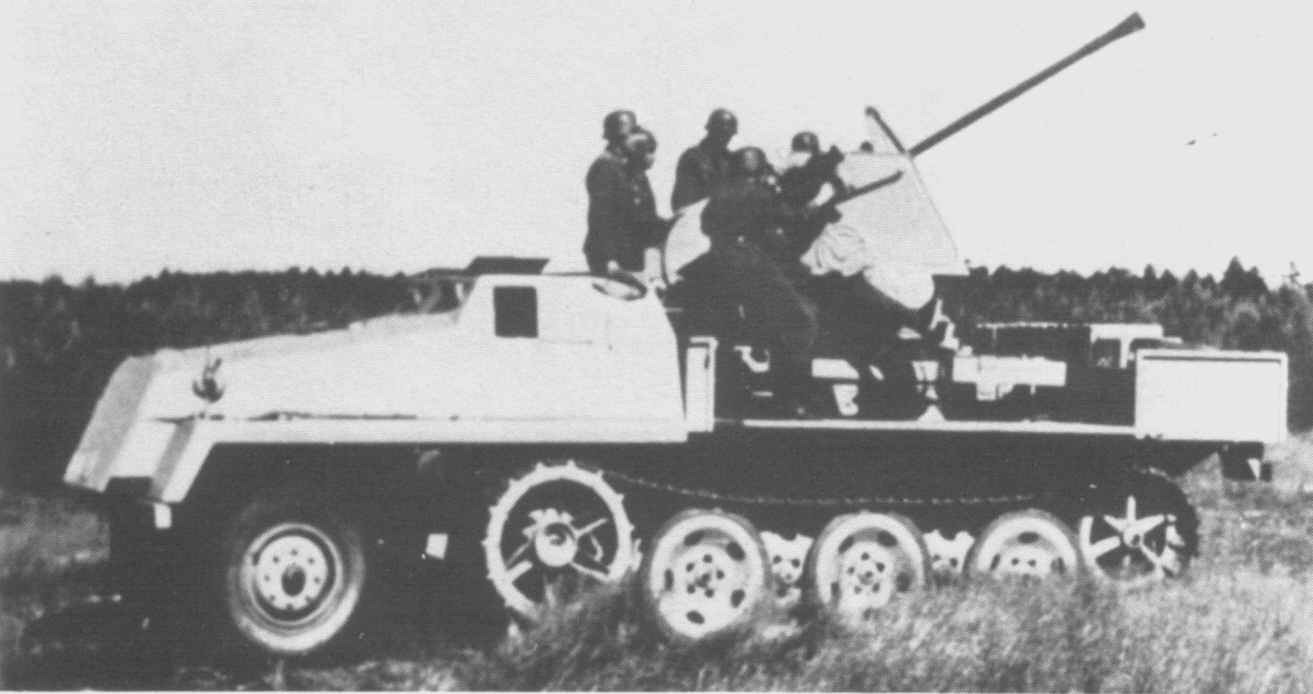- Yes
- No
I would like to suggest the Gepanzerter schwerer Wehrmachtschlepper mit 2 cm Flakvierling 38 L/65. In game it can be placed at a lower Br (around 2.3-2.7) while the gun is quite powerfull with a good fire rate, the chassis however, compared to other halftracts trades allmost all mobility for some armor and strong gears for very high offroad capability with strong gears to be powerfull with towing, transporting and general while slow, allways good mobility, with a top speed of just 27 kmh.
The later stages of the War, the production capacitys where allready hindered by bombing, so ration production of less different models was considdered, so instead of 5 different halftracts as main towing vehicles it was decided to change to just 2-3, namely the leichter Wehrmachtschlepper (which didnt go past the paper stage duo problems and turning out to be not ideal) and the schwerer Wehrmachtschlepper which while overall good and rather easy to produce was far slower than the other models, cince it had so high gearing for high towing strength over speed, which is why in the end it didnt replace the other vehicles. While most were armed with 3,7 cm Flak 43 L/57, the surviving picture also shows with 2 cm Flakvierling 38 L/65
Pictures:(Click to show)
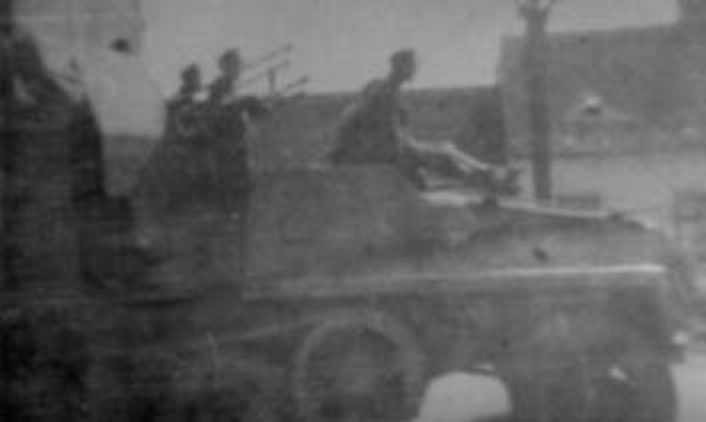
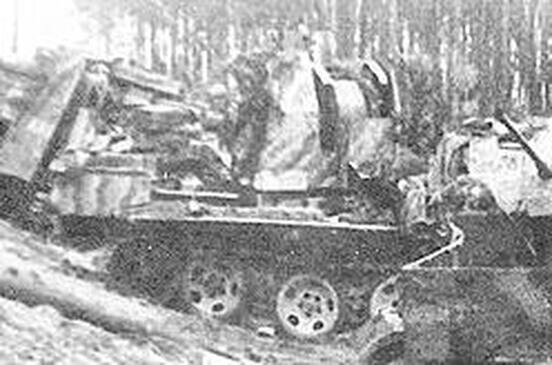
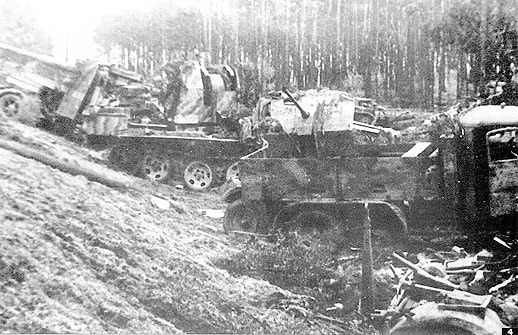
And since there are no other pictures, here with 3,7 cm Flak 43 L/57, to simply see more of the vehicle.
sWS - Fahrzeuge-der-Wehrmacht.de
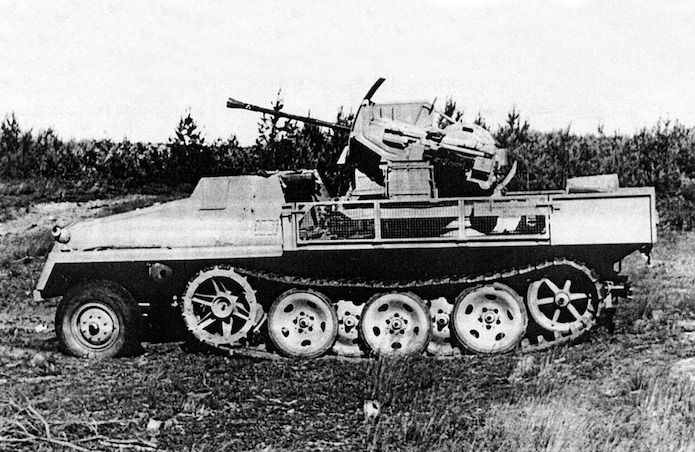





The Chassis: schwerer Wehrmachtschlepper:
Produced by Büssig-NAG (825 produced)
Length: 6,67 m
Width: 2,5 m
Height: 2,8 m
Weight: 13,5 t
Engine: 100 Ps Maybach HL 42
Speed: 27 kmh
Armor 6 to 14,5mm heavily angled with 10-14,5 mm Gunshield.
20mm Flak 30/38 L/65 Info and Ammo loadout
Picture Flak 30:

Picture Gebirgsflak 38:
The Gebirgsflak 38 is a lightweight version, which can be disassebled into 3 pieces to carry it by 3 solders.
The Mounting is also lightweight and has increased vertical traverse for fighting in the mountains.

Picture Flakvierling 38:

Ill put these 2 together cince they have the same L/65 barrle and the same 20x138mmB Rh ammo.
Caliber: 20mm
Ammo: 20x138mmB Rheinmetall
Fire Rate: 280-300 rpm (30) 450-480 rpm (38)
Magazine fed: 20 rounds. In the war greater size magazins were developed, with 30 rounds, 5,3 kg and 40 rounds, 7 kg, both 20 and 40 round magazines were used by Heer and Kriegsmarine.
Muzzle velocity: 800-1050 m/s
Weight: 450kg (30) 405(38) (around 64 and 56 kg KwK (30 and 38) alone)
1509kg (Vierling with trailer) Gebirgsflak 38 176kg
Mounts:
Flak 30 Lafette: -12° to +90°
Flak 38 Lafette: -20° to +90°
Flakvierling 38: -10° to +100°
Ammo Types: Ap-T, ApI-T, Aphe-T, APCR-T, He-I, HeI-T and HeI-T (m) (And self destruct)
AP:
Pzgr. L'Spur. o.Zerl. (Ph.) (ApI-T) 0,148kg 800m/s 37mm/10m
Note: Used against ground targets. Soft and armored. 3g White Phosphor Core. Were fully replaced by the empty ones and later .Zerl in the Desert and other hot places, as the phosphorus had a nasty tendency to self ignite in hot weather. The “Ph.” marked ones were standard with the filler, however they also existed with an “O.” which indicated they didnt have a filler and were only 143g (and 830m/s).



Pzgr. L'Spur o.Zerl. (O.) (Ap-T) 0,143kg 830m/s 38,71mm/10m
Note: Used against ground targets. Soft and armored. White stenciled “O.” (ohne/without) indicated empty projectiles.



Pzgr. L'Spur zerl. (Aphe-T Sd) 0,146/0,148 kg 815/800m/s 2,4g Pent 35mm/10m
NOTE: Against ground and air tragets. Soft and armored.
Regarding weight conflicting source, either 146g and 815m/s or 148g and 800m/s.
It does NOT have a fuze, the filler is for self destruction, in game it would also explode upon impact when shattering, like the japanese 30mm Aphe.


Pzgr.40 L'Spur. o.Zerl. (HVAP-T) 0,100kg 1050m/s 62g core 12x45mm 50mm/10m
Note: Only used against heavy armored targets, where the standart Ap ammo does not penetrate.
(There were 3-4 generations, with ever increasing length and slightly weight, to improve stability.)




Pzsprgr. L'Spur o.Zerl. (Aphe-T) 0,148 kg 800m/s 3,6g Pent 33mm/10m
Note: Mainly (?) used by the Navy and only against ground targets.


Pzsprgr. L'Spur m.Zerl. (Aphe-T Sd) 0,121 kg 900m/s 3,6g Pent 33mm/10m
Note: Mainly (?) used by the Navy and against ground and air targets.



(This last picture is an adaption for the Mg151/20 and uses a different shorter tracer, which results in it beeing also a bit lighter)
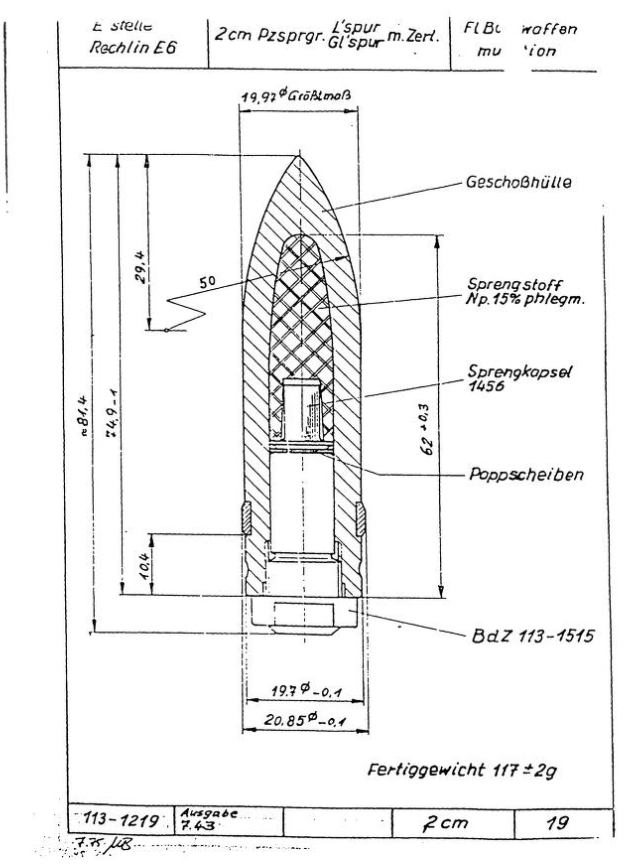
He:
Sprgr. L'Spur m.Zerl. (Hef-T Sd.) 0,115 900-930m/s 6,2g Pent (10,54g) 5mm/10m
Old design without boattail, prewar replaced by Sprgr. L’Spur W, only remaining stock was used in the war. It is not clear wether a velocity beyond 900m/s can be reached regardless of the projectile weight, with the propellant, as its a high pressure quick burning propellant, with quick drop off.

Sprgr. L'Spur. W m.Zerl. (Hef-T Sd.) 0,120kg 900m/s 6,2g Pent (10,54g) 5mm/10m
Against air and ground targets.


Sprgr. Erd. o.L'Spur. o.Zerl. (Hef) 0,120kg 900m/s 11g Pent (18,7g)
Note: Only against groundtargets. Other name is Spr.Gr.39.
(Couldnt find the correct drawing, the Br.Sprgr. o.L’Spur is basically the same, just different filler with Zink.



Brsprgr. L'Spur m.Zerl. (Hefi-T Sd.) 0,120kg 900m/s 6,6g H.5 and Aluminium

Brsprgr. vk. L'Spur m.Zerl (Hefi-T Sd.) 0,120kg 900m/s 19g H.5 and Zink
Note: Against Air and Ground targets, reduced tracer length for increased filler. The full feight of the H.5 and Zink mixture is 19g, not the pure He filler.
(first drawing is either a earlier model or a slighly too short drawn capacity.)

(This italian drawing is more representative.)


Brsprgr. o.L'Spur. m.Zerl. (Hef-I Sd.) 0,120kg 900m/s 20g H.5 and Zink
Note: Against ground and air targets. No tracer at all to have a fully capacity He (H.5) and Incendary (Zink) mix. (Weight calculated by Killakiwi 7g H.5 13g Zink)


Minengeschoss:
M-Gesch. X m.Zerl (He-I (m) Sd.) 0,104kg 950m/s 25g HA 41 (40g)

M-Gesch. X L'Spur m.Zerl (HeI-T (m) Sd.) 0,109kg 950m/s 24g HA 41 (38,4g)

Vehicles:
Flakpanzer I, Flakpanzer 38, Wibelwind, Möbelwagen
Source:
D 606/15 schwerer Wehrmachtschlepper Gerätebeschreibung
Munition der 2 cm Geschütze
German late War armored fighting vehicles
